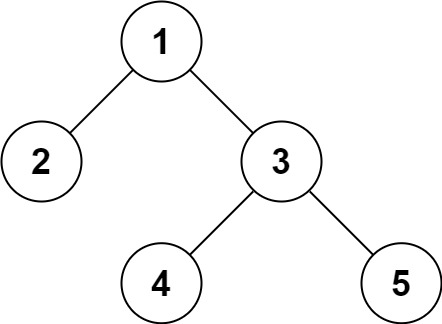Hello, Welcome to my Day 3 of #30Days of Problem Solving and finding solutions to Leetcode's Data Structures and Algorithm questions. Here, I choose a question daily and try to solve it, and finally pen down my process of flow in solving the question.
I hope you find it helpful. Today I will be solving Leetcode's question 297 - Serializing and Deserializing a Binary Tree
Problem Statement
Serialization is the process of converting a data structure or object into a sequence of bits so that it can be stored in a file or memory buffer, or transmitted across a network connection link to be reconstructed later in the same or another computer environment.
Design an algorithm to serialize and deserialize a binary tree. There is no restriction on how your serialization/deserialization algorithm should work. You just need to ensure that a binary tree can be serialized to a string and this string can be deserialized to the original tree structure.
Clarification: The input/output format is the same as how LeetCode serializes a binary tree. You do not necessarily need to follow this format, so please be creative and come up with different approaches yourself.
Example 1:

Input: root = [1,2,3,null,null,4,5] Output: [1,2,3,null,null,4,5]Thought Process/ Intuition
My initial thoughts on solving the problem were to consider the structure of the binary tree and how it could be represented as a string. One possible approach would be to traverse the tree in a depth-first manner and represent each node as a string containing its value and whether it has left and right child nodes. Then, the entire tree can be represented as a string by concatenating the strings for each node in the appropriate order. To deserialize the tree, we could simply split the string representation and recursively construct the tree by creating new nodes for each value in the correct order.
Another possible approach would be to consider the binary tree as a graph and use graph traversal algorithms to serialize and deserialize it. For example, we could use a breadth-first search to traverse the tree and store each node's value and child nodes in a list, which can be converted to a string. To deserialize the tree, we could simply convert the string back into a list and use a breadth-first search to construct the tree by creating new nodes for each value in the correct order.
Overall, the key to solving this problem is to come up with a clear and systematic approach to representing the binary tree as a string and constructing the tree from the string.
The Approach
The problem of serializing and deserializing a binary tree can be solved using a recursive depth-first approach. The idea is to traverse the binary tree in a depth-first manner and store each node's value and child nodes in a string representation. To deserialize the tree, we simply convert the string representation back into a binary tree.
The serialization algorithm can be implemented using a recursive depth-first traversal of the binary tree. At each node, we append its value to the serialized string, followed by a delimiter character. We then recursively call the serialization function on the node's left child, and then on the node's right child. If the node has no children, we append a special character to the serialized string to indicate the absence of a child.
The deserialization algorithm can be implemented using a recursive approach as well. We split the serialized string into a list of values using the delimiter character. We then recursively create new nodes for each value in the correct order, starting with the root node. If the value indicates the absence of a child, we set the child node to None. Otherwise, we create a new node with the value and set its left and right child nodes by recursively calling the deserialization function.
Overall, this approach is simple, efficient, and can handle any binary tree structure.
Code Implementation
# Definition for a binary tree node.
# class TreeNode(object):
# def __init__(self, x):
# self.val = x
# self.left = None
# self.right = None
class Codec:
def serialize(self, root):
res = []
def dfs(node):
if not node:
res.append("N")
return
res.append(str(node.val))
dfs(node.left)
dfs(node.right)
dfs(root)
return ",".join(res)
def deserialize(self, data):
vals = data.split(",")
self.i = 0
def dfs():
if vals[self.i] == "N":
self.i += 1
return None
node = TreeNode(int(vals[self.i]))
self.i += 1
node.left = dfs()
node.right = dfs()
return node
return dfs()
# Your Codec object will be instantiated and called as such:
# ser = Codec()
# deser = Codec()
# ans = deser.deserialize(ser.serialize(root))
Complexity
Time complexity:
0(n)
The time complexity of the serialization and deserialization algorithms for a binary tree is O(n), where n is the number of nodes in the binary tree. This is because both algorithms visit each node exactly once, so the time complexity is proportional to the number of nodes in the tree.
Space complexity:
0(n)
The space complexity of the serialization algorithm is also O(n), where n is the number of nodes in the binary tree. This is because the algorithm stores the serialized string in memory, which requires O(n) space to store all the node values.
Conclusion
In conclusion, the serialization and deserialization algorithms for a binary tree are efficient and space-optimal solutions for storing and retrieving a binary tree's structure and data. These algorithms use a recursive depth-first approach to visit each node in the binary tree and store or retrieve its value and child nodes. The time complexity of both algorithms is O(n), while the space complexity of the serialization algorithm is O(n) and the space complexity of the deserialization algorithm is O(h) or O(log(n)) depending on the height of the binary tree. These algorithms are flexible enough to handle any binary tree structure and can be easily implemented in most programming languages.
